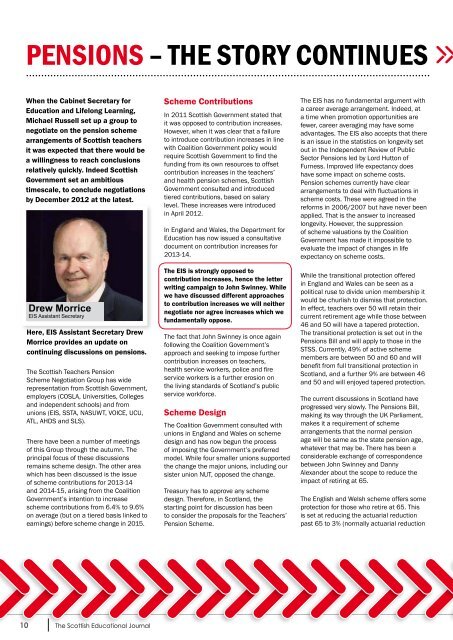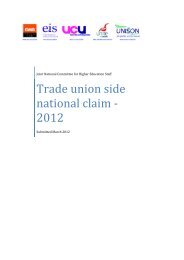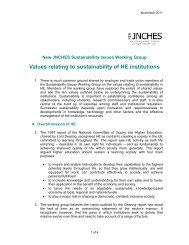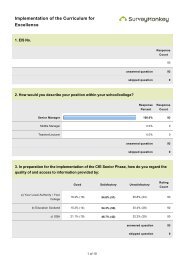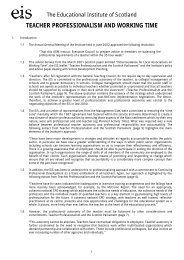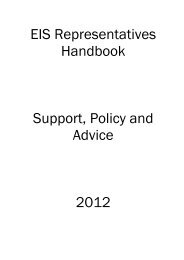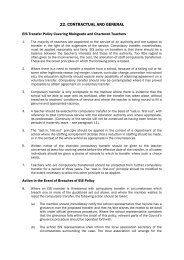The Scottish Educational Journal - EIS
The Scottish Educational Journal - EIS
The Scottish Educational Journal - EIS
You also want an ePaper? Increase the reach of your titles
YUMPU automatically turns print PDFs into web optimized ePapers that Google loves.
PENSIONS – THE STORY CONTINUES<br />
When the Cabinet Secretary for<br />
Education and Lifelong Learning,<br />
Michael Russell set up a group to<br />
negotiate on the pension scheme<br />
arrangements of <strong>Scottish</strong> teachers<br />
it was expected that there would be<br />
a willingness to reach conclusions<br />
relatively quickly. Indeed <strong>Scottish</strong><br />
Government set an ambitious<br />
timescale, to conclude negotiations<br />
by December 2012 at the latest.<br />
Drew Morrice<br />
<strong>EIS</strong> Assistant Secretary<br />
Here, <strong>EIS</strong> Assistant Secretary Drew<br />
Morrice provides an update on<br />
continuing discussions on pensions.<br />
<strong>The</strong> <strong>Scottish</strong> Teachers Pension<br />
Scheme Negotiation Group has wide<br />
representation from <strong>Scottish</strong> Government,<br />
employers (COSLA, Universities, Colleges<br />
and independent schools) and from<br />
unions (<strong>EIS</strong>, SSTA, NASUWT, VOICE, UCU,<br />
ATL, AHDS and SLS).<br />
<strong>The</strong>re have been a number of meetings<br />
of this Group through the autumn. <strong>The</strong><br />
principal focus of these discussions<br />
remains scheme design. <strong>The</strong> other area<br />
which has been discussed is the issue<br />
of scheme contributions for 2013-14<br />
and 2014-15, arising from the Coalition<br />
Government’s intention to increase<br />
scheme contributions from 6.4% to 9.6%<br />
on average (but on a tiered basis linked to<br />
earnings) before scheme change in 2015.<br />
Scheme Contributions<br />
In 2011 <strong>Scottish</strong> Government stated that<br />
it was opposed to contribution increases.<br />
However, when it was clear that a failure<br />
to introduce contribution increases in line<br />
with Coalition Government policy would<br />
require <strong>Scottish</strong> Government to find the<br />
funding from its own resources to offset<br />
contribution increases in the teachers’<br />
and health pension schemes, <strong>Scottish</strong><br />
Government consulted and introduced<br />
tiered contributions, based on salary<br />
level. <strong>The</strong>se increases were introduced<br />
in April 2012.<br />
In England and Wales, the Department for<br />
Education has now issued a consultative<br />
document on contribution increases for<br />
2013-14.<br />
<strong>The</strong> <strong>EIS</strong> is strongly opposed to<br />
contribution increases, hence the letter<br />
writing campaign to John Swinney. While<br />
we have discussed different approaches<br />
to contribution increases we will neither<br />
negotiate nor agree increases which we<br />
fundamentally oppose.<br />
<strong>The</strong> fact that John Swinney is once again<br />
following the Coalition Government’s<br />
approach and seeking to impose further<br />
contribution increases on teachers,<br />
health service workers, police and fire<br />
service workers is a further erosion on<br />
the living standards of Scotland’s public<br />
service workforce.<br />
Scheme Design<br />
<strong>The</strong> Coalition Government consulted with<br />
unions in England and Wales on scheme<br />
design and has now begun the process<br />
of imposing the Government’s preferred<br />
model. While four smaller unions supported<br />
the change the major unions, including our<br />
sister union NUT, opposed the change.<br />
Treasury has to approve any scheme<br />
design. <strong>The</strong>refore, in Scotland, the<br />
starting point for discussion has been<br />
to consider the proposals for the Teachers’<br />
Pension Scheme.<br />
<strong>The</strong> <strong>EIS</strong> has no fundamental argument with<br />
a career average arrangement. Indeed, at<br />
a time when promotion opportunities are<br />
fewer, career averaging may have some<br />
advantages. <strong>The</strong> <strong>EIS</strong> also accepts that there<br />
is an issue in the statistics on longevity set<br />
out in the Independent Review of Public<br />
Sector Pensions led by Lord Hutton of<br />
Furness. Improved life expectancy does<br />
have some impact on scheme costs.<br />
Pension schemes currently have clear<br />
arrangements to deal with fluctuations in<br />
scheme costs. <strong>The</strong>se were agreed in the<br />
reforms in 2006/2007 but have never been<br />
applied. That is the answer to increased<br />
longevity. However, the suppression<br />
of scheme valuations by the Coalition<br />
Government has made it impossible to<br />
evaluate the impact of changes in life<br />
expectancy on scheme costs.<br />
While the transitional protection offered<br />
in England and Wales can be seen as a<br />
political ruse to divide union membership it<br />
would be churlish to dismiss that protection.<br />
In effect, teachers over 50 will retain their<br />
current retirement age while those between<br />
46 and 50 will have a tapered protection.<br />
<strong>The</strong> transitional protection is set out in the<br />
Pensions Bill and will apply to those in the<br />
STSS. Currently, 49% of active scheme<br />
members are between 50 and 60 and will<br />
benefit from full transitional protection in<br />
Scotland, and a further 9% are between 46<br />
and 50 and will enjoyed tapered protection.<br />
<strong>The</strong> current discussions in Scotland have<br />
progressed very slowly. <strong>The</strong> Pensions Bill,<br />
making its way through the UK Parliament,<br />
makes it a requirement of scheme<br />
arrangements that the normal pension<br />
age will be same as the state pension age,<br />
whatever that may be. <strong>The</strong>re has been a<br />
considerable exchange of correspondence<br />
between John Swinney and Danny<br />
Alexander about the scope to reduce the<br />
impact of retiring at 65.<br />
<strong>The</strong> English and Welsh scheme offers some<br />
protection for those who retire at 65. This<br />
is set at reducing the actuarial reduction<br />
past 65 to 3% (normally actuarial reduction<br />
10 <strong>The</strong> <strong>Scottish</strong> <strong>Educational</strong> <strong>Journal</strong>


